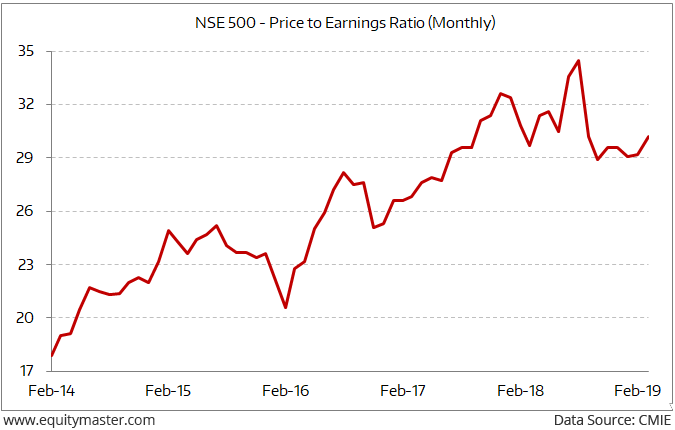- Home
- Todays Market
- Indian Stock Market News June 14, 2019
Sensex Opens Flat; Realty and Energy Stocks Lose Fri, 14 Jun 09:30 am
Asian share markets are lower today as Chinese and Hong Kong shares fall. The Shanghai Composite is off 0.1% while the Hang Seng is down 0.5%. The Nikkei 225 is trading up by 0.3%. US stocks rose on Thursday after two days of declines, as energy shares rebounded with oil on concerns of a supply disruption following attacks on two tankers in the Gulf of Oman.
Back home, India share markets opened flat amid subdued global cues. The BSE Sensex is trading down by 40 points while the NSE Nifty is trading down by 11 points. Both, the BSE Mid Cap index and BSE Small Cap index opened on a flat note.
Barring metal stocks and capital goods stocks, all sectoral indices have opened the day on a negative note with realty stocks and energy stocks leading the losers.
Speaking of Indian share markets in general, how do things look on the valuations front?
The Sensex price to earnings ratio has moved over the last five years. It has mostly been in a rising trend, except some intermittent declines.
But the Sensex tells a very a selective, skewed story of just the 30 largest companies.
So, it would be worth seeing the valuation trend of a much broader index.
Ankit Shah just did that and picked the NSE 500 for his latest study.
What he found was the NSE 500 index was trading cheap before the BJP came to power at the Centre in 2014. Since then, the price to earnings ratio of the index has been trending higher, like the Sensex.
It is interesting to note that the NSE 500 index has almost doubled between February 2014 and now. The price to earnings multiple of the index has gone up almost 70% during the same period, as can be seen from the chart below.
Market Valuations - 2014 to 2019
What does all of this mean?
Here's what Ankit wrote about it in one of the edition of The 5 Minute WrapUp...
- What this means is that the gains have mostly come from valuation multiple expansion and only about 30% from earnings growth.
While the NSE 500 P/E ratio is down 12% from its August 2018 high of 34.5, it's still quite on the higher side.
As such, I believe the key to the next bull run would be a good growth in earnings of listed Indian companies.
Whether this growth comes in, and how, remains to be seen. We will keep you updated on developments from this space.
Moving on, the rupee is currently trading at 69.58 against the US$.
Snapping its two-session gaining streak, the rupee dived 16 paise to close at 69.50 against the US dollar on Thursday amid a sharp rise in crude oil prices.
Brent crude futures, the global oil benchmark, soared 3.8% to US$ 62.27 per barrel after attacks on two oil tankers in the Gulf of Oman triggered fears of supply disruptions.
The rupee opened at 69.33 per dollar and fell further to touch a low of 69.56 at the interbank foreign exchange market.
The local unit finally settled at 69.50, down by 16 paise over its previous close. The rupee Wednesday closed at 69.34 against the US dollar.
Foreign investors purchased shares worth a net Rs 1.7 billion on Thursday, provisional exchange data showed.
The 10-year government bond yield was at 7.01% on Thursday.
The dollar index, which gauges the greenback's strength against a basket of six currencies, was trading 0.04% lower at 96.96.
Speaking of currencies, Vijay Bhambwani, editor of Weekly Cash Alerts, tells you the main reasons why not to trade commodities and currencies the same way you would trade equities. Here's an excerpt of what he wrote...
- Currencies are traded in pairs and the most liquid is the USDINR. Currencies are traded in four decimal points just as bonds are. The international derivative traders association has indicated that forex may be traded in 6 decimals in the coming few years.
It takes months sometimes for the currency pair to pass the next round figure, say from 70 to 71.
Can you really trade commodities and currencies alike or for that matter, equities and currencies alike? Definitely not!
To know more, you can read Vijay's entire article here: Is Trading in Equities, Commodities, and Currencies the Same?
Moving on to the news from the pharma sector. As per an article in a leading financial daily, Wockhardt received zero observations from the US health regulator after inspection of its bioequivalence centre at Aurangabad in Maharashtra.
The United States Food and Drug Administration (USFDA) carried out inspection of the bioequivalence centre located at R&D centre, Aurangabad from June 10 to June 12.
During the inspection, bioanalytical and quality systems of bioequivalence studies of Tamsulosin 0.4 mg capsules and Metoprolol ER tablets were audited, the reports noted.
At the end of inspection, there was nil observation (i.e. zero 483 observation), signifying that best practices were followed, in compliance to regulations.
This outcome would lead approvals of abbreviated new drug applications (ANDAs) in pipeline for which bioequivalence studies are being or will be done in the said centre.
Wockhardt share price opened the day up by 2.6%.
To know what's moving the Indian stock markets today, check out the most recent share market updates here.
For information on how to pick stocks that have the potential to deliver big returns, download our special report now!
Read the latest Market Commentary



Equitymaster requests your view! Post a comment on "Sensex Opens Flat; Realty and Energy Stocks Lose". Click here!
Comments are moderated by Equitymaster, in accordance with the Terms of Use, and may not appear
on this article until they have been reviewed and deemed appropriate for posting.
In the meantime, you may want to share this article with your friends!